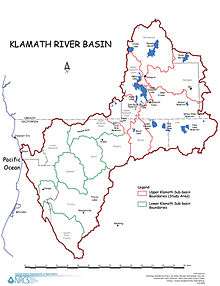John C. Boyle Dam
| John C. Boyle Dam | |
|---|---|
|
John C. Boyle Dam, floodgate open. | |
| Location | Klamath County, Oregon, USA |
| Coordinates | 42°07′25″N 122°02′54″W / 42.123476°N 122.048345°WCoordinates: 42°07′25″N 122°02′54″W / 42.123476°N 122.048345°W |
| Construction began | 1956-58 |
| Dam and spillways | |
| Impounds | Klamath River |
| Height | 68 feet |
| Length | 714.3 feet |
The John C. Boyle Dam is a hydroelectric dam located in southern Oregon, United States.[1] It is on the upper Klamath River, south (downstream) of Keno, and about 12 miles north of the California border.[2] Originally developed and known as Big Bend, the John C. Boyle dam and powerhouse complex was re-dedicated to honor the pioneer hydroelectric engineer who was responsible for the design of virtually all of the Klamath Hydroelectric Project.[3]
The Boyle Diversion Dam includes several sections (earth-fill, concrete gravity, intake and spillway) that combine to form an overall crest length of 714.3 feet with a height of 68 feet. The concrete spillway portion contains three gates and forms the John C. Boyle Reservoir. Fish screens, fish ladder, and related features are also present at the site.[4]
The dam produces power at peak times, meaning sometimes it produces electricity and returns water to the river; other times only a small amount of water is returned to the river. This causes a "bathtub" ring effect downstream of the plant's turbines.
The John C. Boyle Dam is one of four on the Klamath River that would be removed under the Klamath Economic Restoration Act.[5] As of February 2016, the states of Oregon and California, the dam owners, federal regulators and other parties reached an agreement to remove all four dams by the year 2020, pending approval by the Federal Energy Regulatory Commission.[6]
See also
- List of lakes in Oregon
- Klamath River
- Boyle Powerhouse to Copco Reservoir – American Whitewater
| Wikimedia Commons has media related to John C. Boyle Dam. |
References
- ↑ "John C. Boyle Dam". Geographic Names Information System. United States Geological Survey. Retrieved 2009-08-07.
- ↑ http://www.pelicannetwork.net/salmon.boyle.htm
- ↑ http://newwww.pacificorp.com/File/File35389.pdf
- ↑ http://newwww.pacificorp.com/File/File35389.pdf
- ↑ Chris Lehman Clock Ticking For Klamath Dams Oregon Public Broadcasting, Feb. 4, 2010.
- ↑ http://www.sfgate.com/nation/article/New-plan-to-remove-Klamath-River-dams-without-6801869.php
